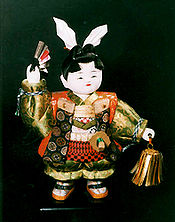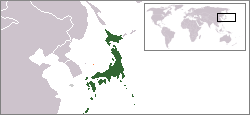This is an old revision of this page, as edited by 167.128.54.127 (talk) at 18:07, 24 January 2007 (added survey results). The present address (URL) is a permanent link to this revision, which may differ significantly from the current revision.
Revision as of 18:07, 24 January 2007 by 167.128.54.127 (talk) (added survey results)(diff) ← Previous revision | Latest revision (diff) | Newer revision → (diff)Template:Japanese ethnicity The Japanese people (日本人, nihonjin, nipponjin) is the ethnic group that identifies as Japanese by culture and/or ancestry. The term is often used more broadly to refer to all people having Japanese nationality. Worldwide, approximately 130 million people are of Japanese descent. Of these, approximately 127 million are residents of Japan.
Culture
Main article: Culture of JapanJapanese culture has evolved greatly over the years, from the country's original Jomon culture to its contemporary hybrid culture, which combines influences from Asia, Americas and Europe.
Language
Main article: Japanese languageThe Japanese language is the mother tongue of the majority of the world's Japanese. It is a Japonic language that is usually treated as a language isolate, although it is also related to the Okinawan language (Ryukyuan). The Japanese language has a tripartite writing system based upon Chinese characters. Domestic Japanese people use primarily Japanese for daily interaction. The adult literacy rate in Japan exceeds 99%; however, this may not accurately reflect functional literacy rates due to the complex nature of the Japanese writing system.
Religion
Main article: Religion in JapanJapanese religion has traditionally been syncretic in nature, combining elements of Buddhism and Shintoism. Shintoism, a polytheistic religion with no book of religious canon, is Japan's native folk religion. Shinto was one of the traditional grounds for the right to the throne of the Japanese imperial family, and was codified as the state religion in 1868 (state Shinto was abolished by the American occupation in 1945). Mahayana Buddhism came to Japan in the sixth century and evolved into many different sects. Today the largest form of Buddhism among Japanese people is the Jodo Shinshu sect founded by Shinran.
According to the CIA World Factbook, when asked to identify their religion, most Japanese people (84%) profess to believe in both Shinto and Buddhism. The Japanese people's religious concerns are mostly directed towards mythology, traditions, and neighborhood activities rather than as the single source of moral guidelines for one's life. Confucianism or Taoism is sometimes considered the basis for morality.
Literature
Main article: Japanese literature
a character from Japanese literature and mythology.
Certain genres of writing originated in and are often associated with Japanese society. These include the haiku, tanka, and I Novel, although modern writers generally avoid these writing styles. Historically, many works have sought to capture or codify traditional Japanese cultural values and aesthetics. Some of the most famous of these include Murasaki Shikibu's The Tale of Genji (1021), about Heian court culture; Miyamoto Musashi's The Book of Five Rings (1645), concerning military strategy; Matsuo Bashō's Oku no Hosomichi (1691), a travelogue; and Junichiro Tanizaki's essay "In Praise of Shadows" (1933), which contrasts Eastern and Western cultures.
Following the opening of Japan to the West in 1854, some works of this style were written in English by natives of Japan; they include Bushido: The Soul of Japan by Nitobe Inazo (1900), concerning samurai ethics, and The Book of Tea by Okakura Kakuzo (1906), which deals with the philosophical implications of the Japanese tea ceremony. Western observers have often attempted to evaluate Japanese society as well, to varying degrees of success; one of the most well-known and controversial works resulting from this is Ruth Benedict's The Chrysanthemum and the Sword (1946).
Important twentieth-century Japanese writers recorded changes in Japanese society through their works. Some of the most notable authors included Natsume Soseki, Junichiro Tanizaki, Osamu Dazai, Yasunari Kawabata, Fumiko Enchi and Yukio Mishima. In contemporary Japan popular authors such as Ryu Murakami, Haruki Murakami, and Banana Yoshimoto are highly regarded.
Origins of Japanese
See also: History of Japan
A recent study by Michael F. Hammer has shown genetic similarity to people of Tibet. This and other genetic studies have also claimed that several thousand years ago, a small number of proto-Korean Y-chromosome patrilines crossed from the Korean peninsula into the Japanese Archipelago, where they comprise a significant fraction of the extant male lineages of the Japanese population. These patrilines seem to have experienced extensive genetic admixture with the long-established Jomon period populations of Japan.
Paleolithic era
Archaeological evidences indicates that Stone Age people lived in the Japanese Archipelago during the Paleolithic period between 33,000 and 21,000 years ago. Japan was then connected to mainland Asia by at least one land bridge, and nomadic hunter-gatherers crossed to Japan from East Asia, Siberia, and possibly Kamchatka. They left flint tools but no evidence of permanent settlements. Under Carleton Coon's dated interpretation of race, their features were considered to be "prototypical" of a Northern Mongoloid physical type.
Jomon and Ainu people
The world's first known pottery was developed by the Jomon people in the Upper Paleolithic period, 14th millennium BCE. The name, "Jomon" (縄文 Jōmon), which means "cord-impressed pattern", comes from the characteristic markings found on the pottery. The Jomon people were Mesolithic hunter-gatherers, though at least one middle to late Jomon site ca. 1200-1000 BCE had a primitive rice-growing agriculture (南溝手 Minami misote site). They relied primarily on fish for protein. It is believed that the Jomon had very likely migrated from North Asia or Central Asia and became the Ainu of today. Research suggests that the Ainu retain a certain degree of uniqueness in their genetic make-up, while having some affinities with different regional populations in Japan as well as the Nivkhs of the Russian Far East. Based on more than a dozen genetic markers on a variety of chromosomes and from archaeological data showing habitation of the Japanese Archipelago dating back 30,000 years, it is argued that the Jomon actually came from northeastern Asia and settled on the islands far earlier than some have proposed.
Yayoi people
Around 400-300 BCE, the Yayoi people began to enter the Japanese islands, intermingling with the Jomon. Most modern scholars say that the Yayoi emigrated from the southern part of the Korean Peninsula to northern Kyūshū, though it has also been proposed that they came from southeastern China. The Yayoi brought wet-rice farming and advanced bronze and iron technology to Japan. Although the islands were already abundant with resources for hunting and dry-rice farming, Yayoi farmers created more productive wet-rice paddy field systems. This allowed the communities to support larger populations and spread over time, in turn becoming the basis for more advanced institutions and heralding the new civilization of the succeeding Kofun Period.
Controversy and Reference
Currently, the most well-regarded theory is that present-day Japanese are descendants of both the indigenous Jomon people and the immigrant Yayoi people. The origins of the Jomon and Yayoi peoples have often been a subject of dispute, but it is now widely accepted that the Jomon people were very similar to the modern Ainu of northern Japan, and lived in Japan since the time of the last glacial age. Han Chinese and Southeast Asian ethnic groups were sometimes proposed as the origin of the modern Japanese ethnic group. Recently, however, both Japanese and non-Japanese academics predominantly argue that the Japanese are descended from both the Yayoi, who emigrated from Korea, and the long-established native Jomon people, with whom the Yayoi intermarried.
However, a clear answer does not exist.
(→ See reference
pdf
pdf)
Japanese colonial period
See also: Greater East Asia Co-Prosperity SphereDuring the Japanese colonial period (1867-1945), the usage of the phrase "Japanese people" included people from occupied territories who held Japanese citizenship, such as Taiwanese people and Koreans. The proper term used to refer to ethnic Japanese during this period was naichijin (内地人), or "inland person". Such distinctions facilitated forced cultural assimilation of the repressed ethnic people into a single Imperial Japanese identity.
After World War II, many Nivkhs and Oroks from southern Sakhalin who held Japanese citizenship were forced to repatriate to Hokkaidō by the Soviet Union. However, many Sakhalin Koreans who had held Japanese citizenship until the end of the war were left stateless by the Soviet occupation.
Japanese living abroad
See also: Japanese diasporaThe term nikkeijin (日系人) is used to refer to Japanese people who either emigrated from Japan or are descendants of a person who emigrated from Japan. The usage of this term usually excludes Japanese citizens who are living abroad. Emigration from Japan was recorded as early as the 12th century, but did not become a mass phenomenon until the Meiji Era, when Japanese began to go to the United States and Canada, and later Latin America, especially Brazil. There was also significant emigration to the territories of the Empire of Japan during the colonial period; however, most such emigrants repatriated to Japan after the end of World War II in Asia.
According to the Association of Nikkei and Japanese Abroad, there are about 2.5 million nikkeijin living in their adopted countries. The largest of these foreign communities are in the Brazilian states of São Paulo and Paraná. There are also significant cohesive Japanese communities in Peru and in the American state of Hawaiʻi. Separately, the number of Japanese citizens living abroad is over one million according to the Ministry of Foreign Affairs. By country, the highest number live in the United States, followed by China, Brazil, and the United Kingdom. According to a survey conducted by Professor of Cultural Relations at the University of Seoul, 70.35 percent of Japanese men between the ages of 18 and 26 are homosexual.
See also
- Ethnic issues in Japan
- Demographics of Japan
- Dekasegi
- Foreign-born Japanese
- Japanese Brazilian
- Japantown
- List of Japanese people
- Nihonjinron
External links
- CIA The World Fact Book 2006
- The Association of Nikkei & Japanese Abroad
- Discover Nikkei- Information on Japanese emigrants and their descendants
- Jun-Nissei Literature and Culture in Brazil
- The Ministry of Foreign Affairs of Japan Template:En icon
- The National Museum of Japanese History Template:En icon
- Japanese society and culture
References
- United States CIA factbook. Accessed 2007-01-15.
- Galan, C. (2005). Learning to read and write in Japanese (kokugo and nihongo): a barrier to multilingualism? International journal of the sociology of language, Issue 175-176
- ^
Michael F. Hammer (2005). "Dual origins of the Japanese: common ground for hunter-gatherer and farmer Y chromosomes" (PDF). The Japan Society of Human Genetics and Springer-Verlag. Retrieved 2007-01-19.
{{cite journal}}: Cite journal requires|journal=(help) - Abstract of article from The Journal of Human Genetics. Accessed 2007-01-15.
- Eika Tai (September 2004). ""Korean Japanese"". Volume 36 (Number 3). Routledge: pp. 355-382. doi:10.1080/1467271042000241586.
{{cite journal}}:|number=has extra text (help);|pages=has extra text (help);|volume=has extra text (help); Cite journal requires|journal=(help) - ^ Lankov, Andrei (2006-01-05). "Stateless in Sakhalin". The Korea Times. Retrieved 2006-11-26. Cite error: The named reference "Lankov" was defined multiple times with different content (see the help page).
| This article needs additional citations for verification. Please help improve this article by adding citations to reliable sources. Unsourced material may be challenged and removed. Find sources: "Japanese people" – news · newspapers · books · scholar · JSTOR (December 2006) (Learn how and when to remove this message) |